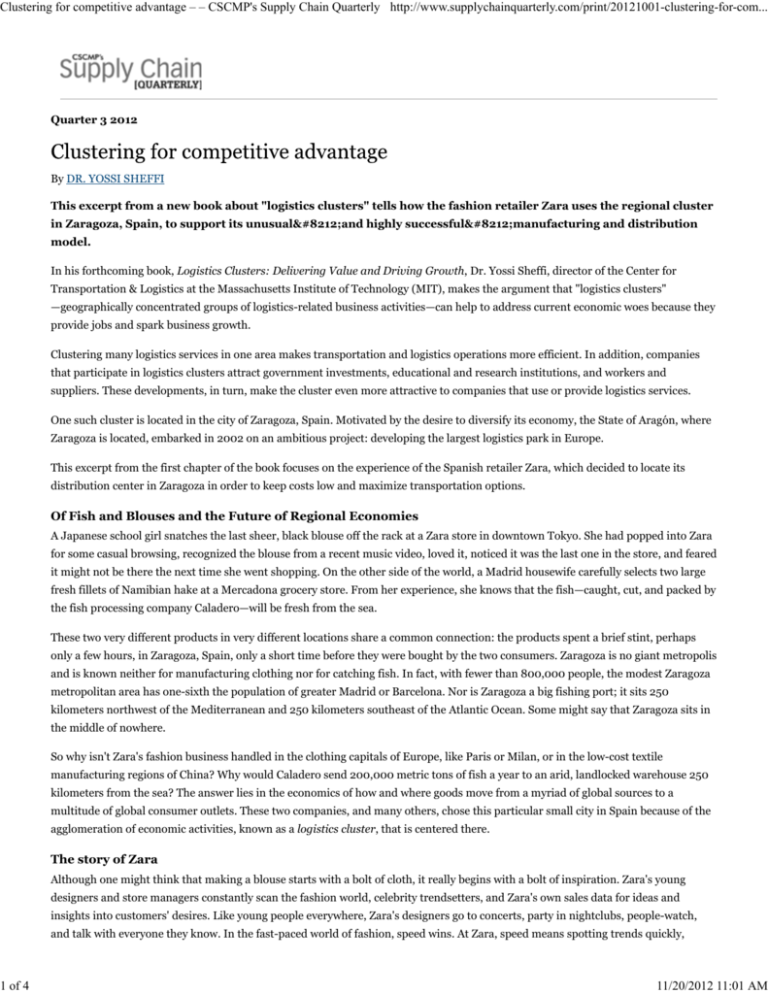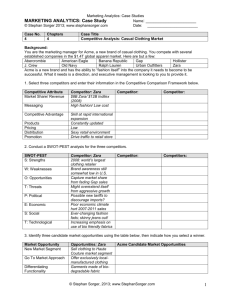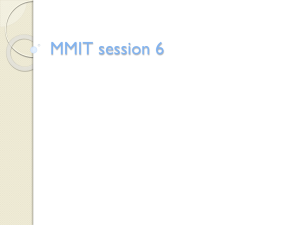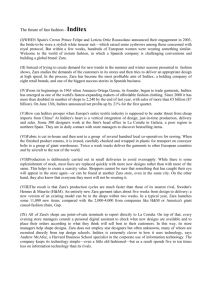
Clustering for competitive advantage – – CSCMP's Supply Chain Quarterly http://www.supplychainquarterly.com/print/20121001-clustering-for-com...
1 of 4
Quarter 3 2012
By DR. YOSSI SHEFFI
This excerpt from a new book about "logistics clusters" tells how the fashion retailer Zara uses the regional cluster
in Zaragoza, Spain, to support its unusual—and highly successful—manufacturing and distribution
model.
In his forthcoming book, Logistics Clusters: Delivering Value and Driving Growth, Dr. Yossi Sheffi, director of the Center for
Transportation & Logistics at the Massachusetts Institute of Technology (MIT), makes the argument that "logistics clusters"
—geographically concentrated groups of logistics-related business activities—can help to address current economic woes because they
provide jobs and spark business growth.
Clustering many logistics services in one area makes transportation and logistics operations more efficient. In addition, companies
that participate in logistics clusters attract government investments, educational and research institutions, and workers and
suppliers. These developments, in turn, make the cluster even more attractive to companies that use or provide logistics services.
One such cluster is located in the city of Zaragoza, Spain. Motivated by the desire to diversify its economy, the State of Aragón, where
Zaragoza is located, embarked in 2002 on an ambitious project: developing the largest logistics park in Europe.
This excerpt from the first chapter of the book focuses on the experience of the Spanish retailer Zara, which decided to locate its
distribution center in Zaragoza in order to keep costs low and maximize transportation options.
Of Fish and Blouses and the Future of Regional Economies
A Japanese school girl snatches the last sheer, black blouse off the rack at a Zara store in downtown Tokyo. She had popped into Zara
for some casual browsing, recognized the blouse from a recent music video, loved it, noticed it was the last one in the store, and feared
it might not be there the next time she went shopping. On the other side of the world, a Madrid housewife carefully selects two large
fresh fillets of Namibian hake at a Mercadona grocery store. From her experience, she knows that the fish—caught, cut, and packed by
the fish processing company Caladero—will be fresh from the sea.
These two very different products in very different locations share a common connection: the products spent a brief stint, perhaps
only a few hours, in Zaragoza, Spain, only a short time before they were bought by the two consumers. Zaragoza is no giant metropolis
and is known neither for manufacturing clothing nor for catching fish. In fact, with fewer than 800,000 people, the modest Zaragoza
metropolitan area has one-sixth the population of greater Madrid or Barcelona. Nor is Zaragoza a big fishing port; it sits 250
kilometers northwest of the Mediterranean and 250 kilometers southeast of the Atlantic Ocean. Some might say that Zaragoza sits in
the middle of nowhere.
So why isn't Zara's fashion business handled in the clothing capitals of Europe, like Paris or Milan, or in the low-cost textile
manufacturing regions of China? Why would Caladero send 200,000 metric tons of fish a year to an arid, landlocked warehouse 250
kilometers from the sea? The answer lies in the economics of how and where goods move from a myriad of global sources to a
multitude of global consumer outlets. These two companies, and many others, chose this particular small city in Spain because of the
agglomeration of economic activities, known as a logistics cluster, that is centered there.
The story of Zara
Although one might think that making a blouse starts with a bolt of cloth, it really begins with a bolt of inspiration. Zara's young
designers and store managers constantly scan the fashion world, celebrity trendsetters, and Zara's own sales data for ideas and
insights into customers' desires. Like young people everywhere, Zara's designers go to concerts, party in nightclubs, people-watch,
and talk with everyone they know. In the fast-paced world of fashion, speed wins. At Zara, speed means spotting trends quickly,
11/20/2012 11:01 AM
Clustering for competitive advantage – – CSCMP's Supply Chain Quarterly http://www.supplychainquarterly.com/print/20121001-clustering-for-com...
2 of 4
crafting designs quickly, making clothes quickly, and getting them into stores quickly.
For example, when Madonna wore a certain blouse at the beginning of her 2005 concert tour, one of Zara's 300 designers realized
that his customers would love the singer's look. And with an average of 50,000 screaming fans per concert location, the designer
knew that Zara could sell a lot of clothing if it could get the blouse into stores before the concert tour's buzz wore off.
Most clothing retailers could never have hoped to tap into Madonna's new look without extensive preparations, market research, and
the approval of senior managers—a process spanning many months. These slow and careful processes mean that most clothing
retailers stick to just two to four carefully planned major seasons per year (their spring/summer, fall/winter collections).
But Zara isn't like most retailers. When Zara designers see a hot new look, they have the authority to do what it takes to bring the idea
to market. Zara's designers don't need endless committee meetings to launch a new line or tinker with an existing one. They are
empowered to tap inventories, redesign garments, authorize manufacturing (by trusted local seamstresses who can quickly sew the
pattern), and then ship the new clothing off to stores. In this particular case, Zara designed a Madonna concert-inspired blouse and
got it into stores in only three weeks, before Madonna finished her tour.
Zara's speedy response to the Madonna concert wasn't a one-off fluke or the result of a special effort. To go from idea to sales, Zara
needs just five to six weeks for totally new designs and only two weeks for a modified design. Thus, as The Economist reported,
"When Spain's Crown Prince Felipe and Letizia Ortiz Rocasolano announced their engagement in 2003, the bride-to-be wore a stylish
white trouser suit—which raised some eyebrows among those concerned with royal protocol. But within a few weeks, hundreds of
European women were wearing similar outfits"—designed, made, distributed, and sold by Zara.
Zara's fast design-to-display operation may seem risky, but Zara makes only small batches of new styles. If the new style fails to sell
well in the first week, Zara cancels it. If a new design does sell well in the first week, Zara might make more until some other new
design supplants the old one. Few clothes stay in the warehouse for long. In an average two-month period, the stock turnover will be
around 70 percent. Zara's speed has earned it a sterling supply chain reputation; the stores get all the replenishment products they
demand in less than two days.
With so many new styles every week in Zara stores, customers know they will always find something fresh and exciting when they
shop. They also know that they need to buy fast, because Zara replaces styles very quickly. As Luis Blanc, a director for Zara's parent
company, Inditex, explains, "Most important, we want our customers to understand that if they like something, they must buy it now,
because it won't be in the shops the following week. It is all about creating a climate of scarcity and opportunity." The result: the
average Zara customer visits a Zara store an average of seventeen times per year, compared to an average of three visits per year for
customers of other clothiers.
Local labor: A small price to pay for faster response
Haute couture, perhaps, but Zara can't be expensive. To keep costs low, Zara optimizes and automates its logistics operations.
Leading-edge robots take instructions from state-of-the-art algorithms to handle most of the tasks in Zara's massive distribution
center, which is located in the middle of the immense Zaragoza logistics park.
Although Zara automates many manufacturing and logistics activities, sewing still requires deft human hands. For fast-fashion items,
like the Madonna-inspired blouse, Zara relies on a network of hundreds of local sewing cooperatives in northwestern Spain and
northern Portugal. Although these small shops are among the least expensive in Europe, their labor costs are six to sixteen times
higher than those of their Chinese counterparts used by most other clothiers.
But Southern European workers offer something that China can't: affordable speed. Ocean freight from China to Europe adds three to
seven weeks to the design-to-display process and to the replenishment cycle time. Fast airfreight from China to Europe costs many
times more per kilogram than ground transportation within Europe (and has a heavy carbon footprint). Using nearby producers
means fast turnaround—an order of magnitude faster than competitors—obviating the need to forecast what customers will want
many months in advance. As a result, Zara stocks lots of fresh merchandise on the shelf when consumers want it and avoids having
too much stale merchandise that can be moved only by lowering the price. Fast revenues and very little discounting lead to superior
financial results. "If you produce what the street is already wearing, you minimize fashion risk," notes José Luis Nueno, a marketing
professor at IESE Business School in Barcelona. To get from hundreds of factories to hundreds of stores—each with the right
11/20/2012 11:01 AM
Clustering for competitive advantage – – CSCMP's Supply Chain Quarterly http://www.supplychainquarterly.com/print/20121001-clustering-for-com...
3 of 4
assortment, colors, and sizes—Zara uses the Zaragoza distribution center.
Zara comes to Zaragoza
Despite the similarity of names, Zara didn't start in Zaragoza but in the town of Arteixo in the extreme northwestern corner of Spain,
just off the Atlantic's Bay of Biscay. Zara grew rapidly thanks to its savvy eye for fashion and quick design-produce-distribute retailing
model. As the company expanded, it started thinking about a location for a new state-of-the-art distribution center to handle the
shipments to retail outlets in the 77 countries where it does business. "We needed a location closer to Europe than the existing facility
in northwest Spain," said Raúl Estradera, Zara's director of communications and industrial relations. "It needed to have a good
transport infrastructure and qualified human resources."
While Zara's parent company, Inditex, was inking a deal with the Spanish community of Catalonia to build a large new distribution
center in Barcelona, the neighboring state of Aragón and the city of Zaragoza were crafting a bold plan to build the largest logistics
park in all of Europe, called PLAZA (Plataforma Logística de Zaragoza). Zaragoza and Aragón envisioned a literal "green field"
development that would convert farmland into a bustling 1,200-hectare (3,000-acre) logistics park with excellent highway, rail, and
airfreight connections. Hearing of Inditex's intention to build in Barcelona, the creators of PLAZA rushed to woo the retailer to
PLAZA. PLAZA's organizers knew that Inditex's reputation for logistics expertise would make Inditex a key first customer that would
validate the PLAZA project. If Inditex said "yes," then others would come to PLAZA, too. And if Aragón could get PLAZA off the
ground, the large size of the park and the resulting economies of scale would deter others in southeastern Europe from building
competing facilities.
Inditex agreed to abandon the Barcelona deal and come to Zaragoza, but only if PLAZA accelerated its development plans to meet
Inditex's schedule for opening the distribution center. Inditex insisted on stiff, multimillion-euro penalties for any delays, and
PLAZA's government developers—with obvious trepidation—agreed. In 2002, Inditex sent a team led by Jorge Méndez, Lorena Alba,
and Juan Villacampa, who make up the core of the firm's logistics department, to Zaragoza to oversee the development of what was at
the time the first fully automated warehouse facility for Inditex. By 2003, Inditex had inaugurated the gargantuan distribution center,
covering a whopping 120,000 square meters (1.3 million square feet)—about the size of 23 American football fields—under one roof.
The structure is 20.8 meters high, or about seven stories.
Orderly ordering: A choreography of clothing
Zara's distribution center typifies the kind of activities that take place in modern distribution facilities. Twice a week, Zara replenishes
its stores to keep the latest fashions in stock and to deliver new designs to its retail outlets. Store managers review the list of available
items provided by headquarters and submit their orders by 7 o'clock every Monday morning, after the busy weekend selling period.
Zara's commercial department then allocates inventory to stores, a process that includes the challenge of allocating high-demand
clothing for which store orders exceed the available supply. Next, Zara's warehouse management system (WMS) converts the clothing
allocations into millions of commands to robots that pull the allocated articles of clothing out of storage, place them onto conveyors,
and send them to the automated sorting equipment that routes each garment to the right packing area. Once packed, each box of
garments is loaded and shipped to one of more than 1,500 Zara stores worldwide.
Zara's systems automation manager, Jorge Savirón, is a man with a mission. "The job we have here at the distribution center is to
serve the stores with the products they need, on demand and on time," he told me as we walked through the mammoth building. To
keep equipment utilization high, this automated warehouse splits each of the two weekly picking-and-packing operations into four
half-day batches: one on the Monday/Tuesday and the other on the Thursday/Friday work cycle. On each day, sorting ends by 5 p.m.
to meet the loading deadline for the outbound trucks and airfreight shipments at the nearby Zaragoza airport.
Although 800 people work inside the Zara distribution center in Zaragoza, the vast scale of the facility, the extensive automation, and
the multiple work shifts make the building seem eerily empty. A few people appear here and there, standing out amid the shine of
state-of-the-art mechanical equipment housed in the enormous complex. Robots replace manual-labor workers, conveyors replace
forklift drivers, bar codes and scanners replace human eyes, and computers replace paper files and clipboards. Workers oversee the
machines, monitor the progress of each picking, packing, and loading cycle, and make sure the right clothes go to the right store on
the right truck. Ubiquitous computer terminals and handheld scanners make it possible for a small crew to handle millions of items a
week under tight deadlines with a high degree of accuracy.
11/20/2012 11:01 AM
Clustering for competitive advantage – – CSCMP's Supply Chain Quarterly http://www.supplychainquarterly.com/print/20121001-clustering-for-com...
4 of 4
Trucks outbound, inbound, and all around
On one side of the distribution center, workers load clothes into dozens of trailers for delivery to Zara stores around Europe. Because
no one Zara store needs a full truckload of clothing twice a week, Zara consolidates multiple store orders on each trailer. Workers load
each trailer in reverse order of deliveries: the last box in the trailer will be the first one out at the first delivery stop. In some cases, a
truck from Zaragoza drops its load at a small distribution center in the destination country or city, and smaller trucks perform
capillary distribution to the individual stores. Clothes bound for overseas outlets go by air.
When the workers load the last item in a trailer, a big, silver Mercedes tractor backs up to that trailer, hitches to it, and pulls the
trailer onto Spain's wide-open highways for the delivery run. On the other side of the warehouse, similar silver Mercedes trucks back
their trailers into the distribution center's loading bays to replenish the warehouse. As of 2011, Zara could deliver product ready for
sale to all European stores within 24 hours and all stores worldwide within 48 hours.
Wanted: More space and more speed
As Zara grew from a single store opened in 1975 on a downtown street in A Coruña, Spain, to more than 1,500 stores worldwide in
2011, it grew its Zaragoza distribution center as well. Only a few years after the Zaragoza facility opened, Zara enlarged it by 50
percent to a total of 180,000 square meters (nearly 2 million square feet). Adding physical floor space was just one of Zara's solutions
to growth. Innovation, in the form of new processes and upgraded software, doubled the capacity of key pieces of equipment. While
the size of the Zara distribution center increased by 50 percent, its productive capacity increased by more than 100 percent.
Zara anticipates more growth in the years ahead. By 2014, it expects to sort a million garments per day and have automated storage
systems holding some 34 million articles of clothing. Inditex has invested more than 220 million euros in Zara's Zaragoza distribution
center, generating 800 direct jobs and an estimated 1,600 to 2,000 indirect jobs.
Editor's Note: Logistics Clusters: Delivering Value and Driving Growth will be published by MIT Press in October 2012. It can be
pre-ordered for $29.95.
Copyright © 2012 CSCMP's Supply Chain Quarterly, a publication of
Supply Chain Media, LLC. All rights reserved.
HOME | SUBSCRIBE | MEDIA FILE | CONTACT US | STAFF LIST
CSCMP's Supply Chain Quarterly, Tower Square, Number 4, 500 E.
Washington St., North Attleboro, MA 02760
CSCMP's Supply Chain Quarterly is published by Supply Chain Media
LLC, a joint venture of CSCMP and AGiLE Business Media LLC. The
views and opinions expressed in articles appearing in CSCMP's Supply
Chain Quarterly are the authors' and do not necessarily reflect those of
the Council of Supply Chain Management Professionals or of Supply
Chain Media LLC.
11/20/2012 11:01 AM









